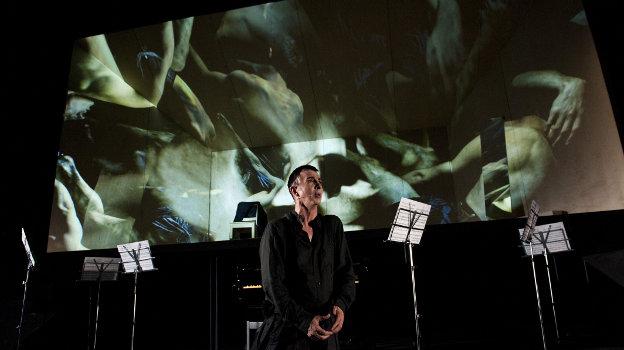In London the plague came in 1665: ‘one hundred thousand dead but I alive’.
This is not the opening line from Ten Plagues but the ending, the epilogue, a joyful ‘I will survive’ statement from our protagonist, who has worked his way though fear, disgust, panic, loneliness, isolation, superiority, and humility to reach this point of liberation. Along the way he has encountered empty churches, fleeing physicians, lost lovers, greedy butchers, swelling groins, blistering bodies, heaving plague pits, and grieving mothers.
Ten Plagues is a contemporary music theatre work, a song cycle with libretto by playwright Mark Ravenhill. The texts are based on eyewitness accounts from 1665 – in which the city of London was ravaged by plague and ‘one third died, one third fled, and one third survived’ – and informed by Pepys’ diaries and by Daniel Defoe’s A Journal of the Plague Year. The music is composed by Conor Mitchell, our nameless plague survivor is played by iconic post-punk pop star Mark Almond, and the show is directed and designed by Stewart Laing. In the clever marrying of scenography and music, there are echoes for me of the work of Heiner Goebbels, and of young company 1927 who similarly use a mix of filmed and staged action which is supported by the key musical role of a solo pianist (and they also share an obvious scenographic interest in German expressionism).
At the start of the piece, we are seduced into believing that there will be a large musical ensemble performing; music stands (at least fifteen or sixteen) are spread across the width of the stage, on either side of the piano. Above is a set-within-the-set, an open-fronted box that is a bare-walled room fitted only with a wooden chair and a mirror. The stands stay unused, ghostly figures, the faceless hordes who died, perhaps, or the nameless occupants of the city. So just a lone pianist (Conor Mitchell I assume, although this isn’t stated), and singer Marc Almond, both clad in black kilt-like ‘skirts’, trousers and jackets, a look reminiscent of Vivienne Westwood’s Seditionaries phase.
Marc Almond is, as always, a mesmerising presence onstage, but oddly – given that the words and music were written for him – there are times when the musical range seems to be challenging for his voice. Less surprisingly, there are times when he doesn’t seem 100% comfortable with the simple, dynamic choreography – reminding us that, actually, acting isn’t easy: perfecting the simplest onstage physical actions such as walking, sitting, and standing still are a lifetime’s work for the actor.
Where he comes into his own fully are the sections that play the Kurt Weil / Jacques Brel / Music Hall card to the max: for example, in a gorgeous scene where he denotes a newly-shaven head (no fleas, no lice!) by donning a tight hairnet, then scoops a wig out of the skirting board, and flirts with himself in the mirror: ‘I’ve bought a wig … and in the mirror I admire myself for hours.’
In other memorable moments, led by the scenography, friends and lovers are played by filmed figures who enter and leave the boxed space, untouchable others; the empty buildings and fleeing masses are portrayed by contemporary, speeded-up and layered footage of London’s city centre; and our hero’s moodswings are mapped by a constantly changing palette of colour washes, from jaundice yellow to sky blue via putrid greens. This, perhaps, a reference to Edgar Allan Poe’s Masque of the Red Death and the succession of differently-coloured rooms passed through, an image that has also been appropriated in recent times by Punchdrunk and in the David Hughes/Al Seed collaborationThe Red Room. There are also, for me anyway, strong echoes of Orhan Pamuk’s first novel The White Castle, which tells the tale of Istanbul’s plague.
Perhaps it is fair, though, to say that this is a universal human story: from the biblical ten plagues to AIDS, the fear of plague, and survival of infections that sweep communities, is a key part of the story of how we have all come to be here still. We’re all the sons and daughters of survivors, so this story is our story.


